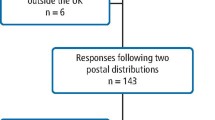Abstract
Design Randomised controlled trial.
Case selection In order to assess baseline knowledge of dental trauma, paediatric dentists and medical students were administered a pre-test, subsequent to which a random assignment was carried out to one of three learning groups: mobile app clinical decision support tools (CDST), print CDST and no CDST, for the purposes of a post-test.
Data analysis The correct answers for the pre-test and post-test, time to completion and answers to the demographic survey were subjected to descriptive statistical analyses using IBM SPSS v25.0 for Windows (SPSS, IBM Corp, Armonk, NY). In order to compare the pre- and post-tests for each group, a paired-sample t test was conducted. An independent-sample t test and Pearson χ2 test were utilised to assess for significant differences between paediatric dentists and medical students. Least significant post-hoc and one-way analysis of variance (ANOVA) tests were conducted among the three groups. The level of significance was set at p <0.05.
Results Paediatric dentists obtained significantly higher scores on both the pre- and post-tests when compared to medical students (8.57 ± 0.96 vs 4.20 ± 1.58; p <0.001 and 8.37 ± 1.09 vs 4.96 ± 1.99; p <0.001, respectively).No significant difference was noted pertaining to the time taken to complete the tests among both the groups. In both the groups, the highest scores were obtained by those who used the mobile app version of the CDST; these subjects, however, recorded the longest time to complete the post-test (p <0.001).
Conclusions When compared to the absence of an aid, both the mobile app and print versions of the CDST improved the diagnosis and management of injuries to the primary dentition. With medical students demonstrating significant improvement in primary dental trauma management with CDST usage, these tools are recommended to enhance the diagnosis and treatment for such patients.
This is a preview of subscription content, access via your institution
Access options
Subscribe to this journal
Receive 4 print issues and online access
$259.00 per year
only $64.75 per issue
Buy this article
- Purchase on Springer Link
- Instant access to full article PDF
Prices may be subject to local taxes which are calculated during checkout
Similar content being viewed by others
References
Lam R. Epidemiology and outcomes of traumatic dental injuries: a review of the literature. Aus Dent J 2016; 61: 4-20.
American Academy of Pediatric Dentistry. Guideline on management of traumatic dental injuries. Paediatr Dent 2017; 39: 420-428.
Mendonca E A. Clinical decision support systems: perspectives in dentistry. J Dent Educ 2004; 68: 589-597.
Author information
Authors and Affiliations
Rights and permissions
About this article
Cite this article
Sahni, V., Gupta, S. Do clinical decision support tools have a role to play in dealing with paediatric dental trauma?. Evid Based Dent 23, 74–75 (2022). https://doi.org/10.1038/s41432-022-0271-x
Received:
Accepted:
Published:
Issue Date:
DOI: https://doi.org/10.1038/s41432-022-0271-x



